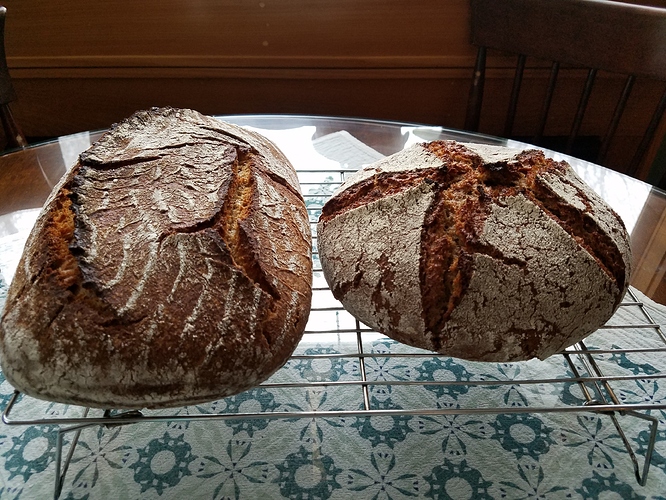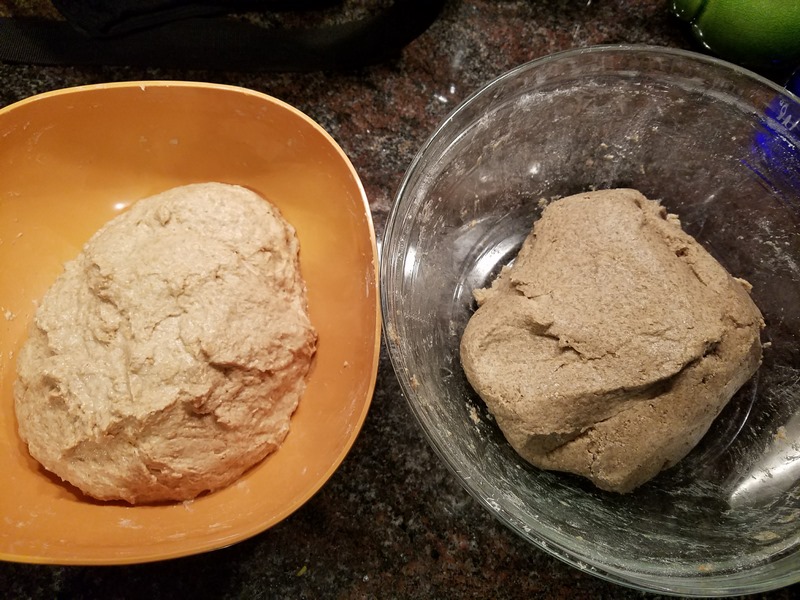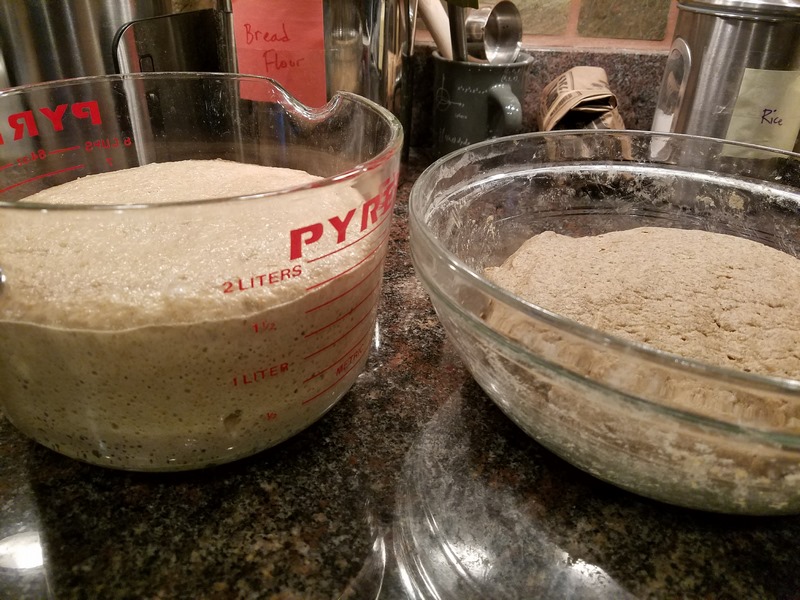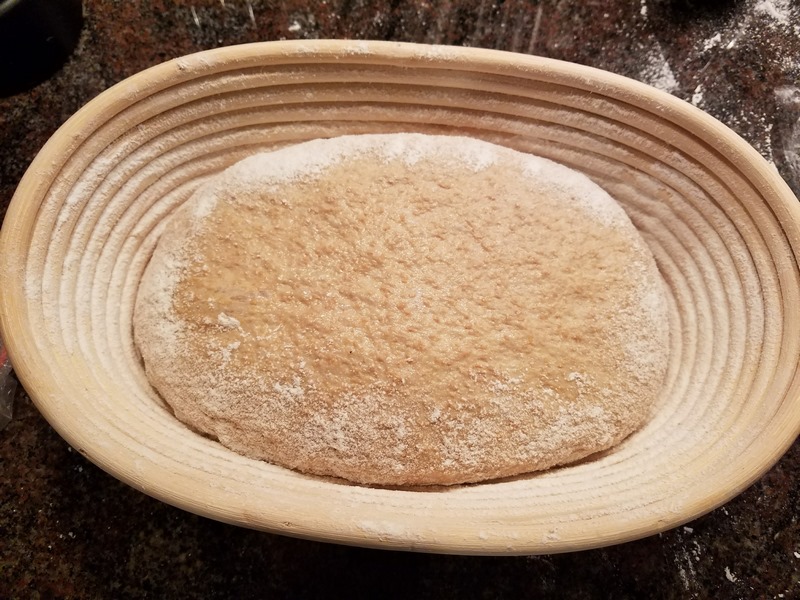Thanks Eric, just the yeast…
Bread machine yeast, assuming it’s fresh and viable, is typically quite vigorous. It acts way faster than sourdough starter and much much less of it is required to get good oven spring. I would probably try using only about a 1/2 teaspoon of bread machine yeast at first, give the dough enough time to rise, and see how it goes. I can’t even begin to guess how long “enough time” is going to be. You just have to plan your life around the proofing so you can roughly monitor it and be around when the dough is ready for the next step.
It is a nice recipe. I’m Dutch, so I love a hard crust. I didn’t have a sourdough starter, so I made a sponge with regular yeast for overnight rising. The next morning I finished making the dough and followed your instructions. Except I didn’t have a proofing basket. So I proofed it in the ceramic bowl I used for the baking. Since you put a lot of flour in that basket, I guess it prevented the bread from sticking to the baking dish. My bread came out nice, but it was totally stuck to the baking dish, should I have added a good flour dusting before baking?
A well floured tea towel draped in the bowl can function similarly to a cloth lined proofing basket. It can be a little clumsy when it comes to inverting the dough onto your baking surface, as the cloth may fall out along with the dough, but ultimately this usually works better than not using a towel at all.
I made this last night and into the morning. I decided to do a all-rye loaf at the same time because I hate to heat up the oven for just one loaf.
I used the same proportions for the whole dark rye flour as for the spelt. The rye was a dryer dough for sure. Live and learn. I also used AP starter in both. No stretch and folds for the rye. Three s&f at 20 min intervals for the spelt.
I heated the oven to 500’ because I was on autopilot and forgot the recipe said 450, but dropped the temp when it was time to put the bread in and I remembered.
450 30 min lid on
450 8 min lid off rye, lid on spelt (cookie sheet under rye which was in cast iron)
Rye out
450 8 more min lid off spelt
Spelt out
Spelt on left, rye on right. Can’t wait to serve the rye with cream cheese and salmon. I have no idea what spelt tastes like so I have no specific plans for it yet.
This one has been great in the clay baker. At this point, it’s safe to say that the spelt bread is one of my family’s favorites. Thank you!
Hi! Greetings from the Netherlands.
I’ve been baking bread for over 10 years now, allways using spelt and sourdough and very wet dough (not unlike the one in this recipe) in molds, But I allways ended up with an unelastic bread with a so-so crust (because I just put it in molds and let it rise). I read sometimes about methods for improving (using more heat for rising and steam in the oven) but never really got into that.
So I tried this recipe with an improvised Romertopf, in my Gas oven and my own trusty spelt wholemeal and sourdough and it came out Superb!!! Wow I never knew that a few stretch and folds made such a difference. I guess that kneeding the dough more doesn’t help because it more likely destroys the gluten strands than builds them.
Thanks for this recipe, will try more of em!
Regards,
Joris
Hi, I have a Romertopf Clay baker, but I’ve always been told you have to soak it first before cooking in it, or it could shatter. You used it dry. How long have you been using it this way?
Many years of heavy usage. Since I preheat it before putting the dough in to bake, any water from soaking would evaporate away by the time it was fully preheated. So I don’t bother. Doing it this way doesn’t increase the risk of cracking.
For the first time this week, I made this loaf without adding any honey. That was actually a nice change, and I’m not sure why I’d never tried it. I was surprised how much of a difference just the honey seems to make in the final flavor and color of the bread. But even prior to baking, the dough itself felt different during the rounds of stretch and fold.
Phillip –
I have a newbie question here about leaving honey out of the Whole Spelt Sourdough recipe. Does leaving the honey out make the dough less sticky and easier to handle?
We’re finding that our spelt dough is sticking to our hands more than we expected.
Onward!
– Guy
Hi, Guy.
Perhaps surprisingly, no, I don’t recall thinking that the dough was any less sticky. The biggest difference was in the final flavor of the loaf (more on the tangy/sour side), as well as in the caramelization of the crust. With honey, there’s noticeably better caramelization during the baking, so I’d recommend keeping it in the recipe.
What’s the surrounding temperature where you’re doing the mixing and stretching? I guess it’s possible that if it’s really cool (i.e., under 70–71F), the dough may need a little more time to rest prior to performing the stretch and fold. One hour of resting is normally good for getting the dough thoroughly hydrated and ready to handle, but it should be determined on the basis of stuff like the temperature where you’re actually making the bread.
Something else to consider with sticking is to wet your hands a bit before picking up the dough. I’ve found that to be very effective. Also, at least when I was just starting, I remember feeling like dough was really sticky – but I had less of an issue with it when I consciously began handling the dough gently yet “decisively,” for whatever that’s worth. It almost seems like treating it too warily leads to more of a mess.
I hope that helps, at least somewhat!
Phillip
Greetings, Phillip –
Thank you for the great information. It’s encouraging to know that you had a similar experience with the sticky dough at the beginning. I tried wet hands and lightly floured hands and the dough still seemed to be sticky. Your point about learning how to handle the dough – “gently yet ‘decisively’” – makes a lot of sense. I think my inexperienced brain expected the dough to handle differently.
You must have ESP because your estimate of the temperature is right on the money. The galley was right in the 70-71° F range when we were stretching the dough. We allowed the dough to rest for an hour after mixing, and then went into the stretch and fold every 15 minutes routine. I think we’ll try 30-minute intervals between stretches and see how that changes things.
Thanks again for the help AND for the great starter!
Onward…
– Guy
My main question (read below for background) is, I finally received a wonderful Brod and Taylor bread proofer for a present, in my attempt to achieve a decent loaf with this recipe.
Can someone guide me on a more accurate temperature and time to use for first and second rise, (rather than just, leave overnight to rise, then proof in morning for 1-1.5 hours,) so that I can actually consistently produce a tasty well-risen loaf? TIA!!!
I have been making this recipe on and off for the past few years! with no consistent results  Because I stubbornly only want whole grain sourdough bread. Can anyone help me achieve better results? Every so often it comes out ok but most of the time not. Today my starter was definitely healthy, but I think I may have let it rise too long on this particularly hot day (finished making it about 1pm and by 6 or 7pm it had risen a LOT! I guessed at that point I had waited too long but just went ahead and shaped for the final proof. What should I have done instead at that point? Punch down and let rise again? Waited longer for the final proof? (It was maybe an hour, but then I got no oven spring
Because I stubbornly only want whole grain sourdough bread. Can anyone help me achieve better results? Every so often it comes out ok but most of the time not. Today my starter was definitely healthy, but I think I may have let it rise too long on this particularly hot day (finished making it about 1pm and by 6 or 7pm it had risen a LOT! I guessed at that point I had waited too long but just went ahead and shaped for the final proof. What should I have done instead at that point? Punch down and let rise again? Waited longer for the final proof? (It was maybe an hour, but then I got no oven spring  )
)
…Sometimes my starter is perhaps not the best, most of the time I still can’t figure out the timing thing, no matter how many tricks I read up on, how to tell when it is ready etc!
Eric,
I’ve become a fan of your sourdough spelt bread, and have begun to vary it with flax seeds, pickled jalapenos and gouda. Your rye bread with orange is also excellent. I put in a little coffee and cocoa as well.
Hi ! Can you tell me how long did you let the dough to proof?
Believe it or not, I can answer this question about bread I baked more than a year ago because of my obsession with both bread and photography. I was able to look up the photos by date and look at the time on them 
Bulk Fermentation 10 hrs (February cold house), see time stamp on photos as well as growth of the doughs (not sure why I transferred the spelt dough…maybe to see bubble on sides).
Final Proof 1 hour
Wow, thank you for all the pics and info  . Lucky me ! I hope I will make it better next time, because, first time was flat
. Lucky me ! I hope I will make it better next time, because, first time was flat 
I tried this recipe yesterday. Had a few “problems”. Used a rye starter. Dough was exceptionally sticky As others have mentioned. So much so that i could barely fold it and stuck all over my hands. Added more flour to the board each time I folded it. Bulk fermentation was complete at 9 pm so I shaped it as best I could, lined a large bread pan with towel sprayed with a little oil, floured, bran, covered with plastic, put in refrigerator. Took out in am, let set on counter 3-4 hours, baked in clay baker, took lid off after 35 minutes, temp was 160, 10 min later it was 208!! Darn. Nice oven spring, nice color but the crust is very thick. I used 3 tbs honey as called for and don’t like it. Other than being too sweet, it is delicious. Just gotta cut the crust off.
Bread baking schedule did not go as planned because I started about noon. My starter was ready! Just have to figure out how to post a picture




